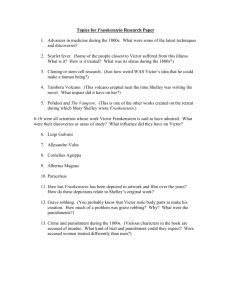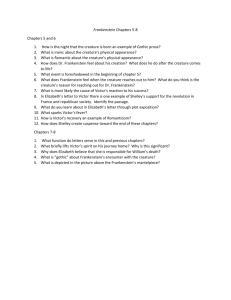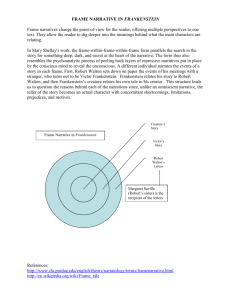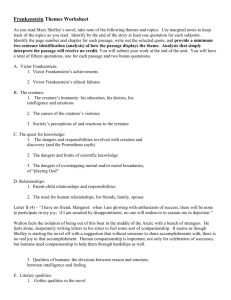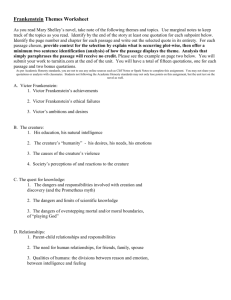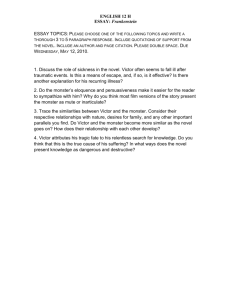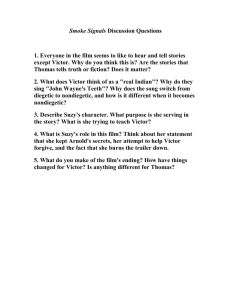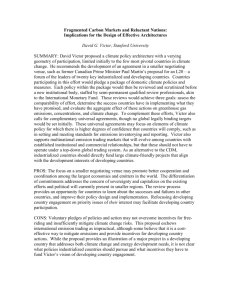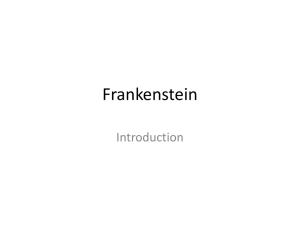ENGLISH 4B SYLLABUS & TIMELINE / MS. PATTERSON
advertisement
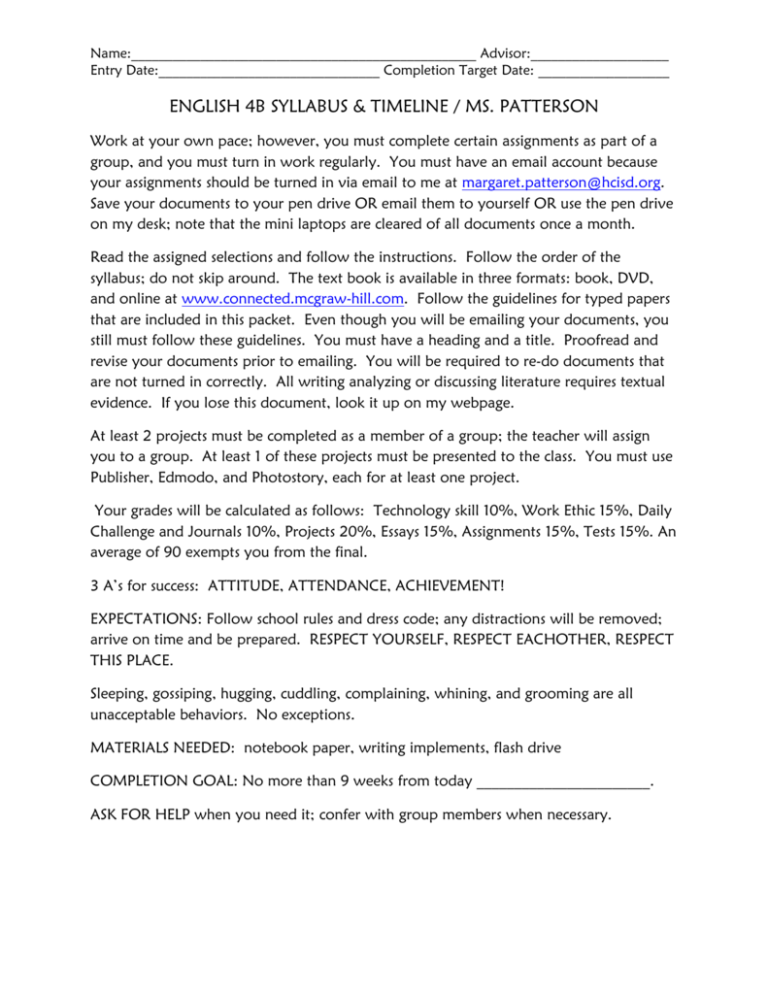
Name:__________________________________________________ Advisor:____________________ Entry Date:________________________________ Completion Target Date: ___________________ ENGLISH 4B SYLLABUS & TIMELINE / MS. PATTERSON Work at your own pace; however, you must complete certain assignments as part of a group, and you must turn in work regularly. You must have an email account because your assignments should be turned in via email to me at margaret.patterson@hcisd.org. Save your documents to your pen drive OR email them to yourself OR use the pen drive on my desk; note that the mini laptops are cleared of all documents once a month. Read the assigned selections and follow the instructions. Follow the order of the syllabus; do not skip around. The text book is available in three formats: book, DVD, and online at www.connected.mcgraw-hill.com. Follow the guidelines for typed papers that are included in this packet. Even though you will be emailing your documents, you still must follow these guidelines. You must have a heading and a title. Proofread and revise your documents prior to emailing. You will be required to re-do documents that are not turned in correctly. All writing analyzing or discussing literature requires textual evidence. If you lose this document, look it up on my webpage. At least 2 projects must be completed as a member of a group; the teacher will assign you to a group. At least 1 of these projects must be presented to the class. You must use Publisher, Edmodo, and Photostory, each for at least one project. Your grades will be calculated as follows: Technology skill 10%, Work Ethic 15%, Daily Challenge and Journals 10%, Projects 20%, Essays 15%, Assignments 15%, Tests 15%. An average of 90 exempts you from the final. 3 A’s for success: ATTITUDE, ATTENDANCE, ACHIEVEMENT! EXPECTATIONS: Follow school rules and dress code; any distractions will be removed; arrive on time and be prepared. RESPECT YOURSELF, RESPECT EACHOTHER, RESPECT THIS PLACE. Sleeping, gossiping, hugging, cuddling, complaining, whining, and grooming are all unacceptable behaviors. No exceptions. MATERIALS NEEDED: notebook paper, writing implements, flash drive COMPLETION GOAL: No more than 9 weeks from today _______________________. ASK FOR HELP when you need it; confer with group members when necessary. BRITISH LITERATURE The Triumph of Romanticism Introduction 1. Read pp. 674-676. 2. Answer the following questions: a. When did the Industrial Revolution begin in Britain? b. What happened in 1776? c. The ideals of the American and French revolutions spread to whom? d. Romanticism sprang from _______________________________. e. Romantic poets were particularly suspicious of ______________________. f. The reaction against Enlightenment became _____________________. g. Sensibility is a kind of __________________________________. h. The Romantic response to the Enlightenment was the _________ which blends _____. 3. Read pp. 680-683. 4. Answer the following questions: a. For the Romantics, the deepest experiences were: b. The French Revolution seemed to offer: c. The Romantic interest in folk culture had important: d. For the Romantics, a great part of the attraction of foreign lands was: e. Romantic poets above all reflected on: 5. Look at the poem excerpt on p. 683. 6. Analyze the poem; write an essay that includes the analysis and intended meaning of the poem. Romantic Poetry 1. Note that “Romantic” is an era of literature, not the idea of love; romantic in this case means a way of looking at the world and a style of writing that sees the beautiful in everything. 2. Read “Elegy Written in a Country Churchyard” p. 686-690. 3. In lines 17-28, what sights, sounds, and feelings does the speaker say the dead have left behind? Summarize the speaker’s feelings about the dead. 4. Look at lines 45-64, 29-44, and 73-76. 5. According to these lines, what are the three themes of this poem? 6. Write a rhyming poem that expresses your feelings about love or death. 7. Read “To a Mouse” p. 695. This poem is written in Scottish English and may not be easy to follow. Write a line by line interpretation of the poem. 8. Read “Auld Lang Syne” p. 697. 9. What does “auld lang syne” mean in English? 10. Write an essay about why this poem/song are meaningful to so many. 11. Write a rhyming poem that recalls something from the past. 12. Read “The Lamb” p. 713 and “The Tyger” p. 714. 13. Write an essay that answers the following: what three things has the lamb been given? what do these three things reveal about the speaker’s attitude toward the lamb? how is the poem “The Tyger” similar to “The Lamb”? how are they different? what do you think the tiger and the lamb symbolize? what is the speaker’s attitude toward The Creator? The Beginnings of the Liberation of Women 1. Read from “A Vindication of the Rights of Women” p. 701. 2. Research the rights of women in England during the 1600s and 1700s. 3. Develop a Power Point or write an essay that explains why women would want more freedoms and rights during this time and compares the rights of women then with the rights of women today; also answer the question, how much do women today get paid for every dollar a man makes? Include your opinion about the struggle for equality around the world. Jane Austen and PRIDE & PREJUDICE 1. Read PRIDE & PREJUDICE and watch the film. 2. Complete one of the following projects: a. Design the Wedding: When you read Jane Austen, you quickly find a running theme of engagements and weddings. Write a newspaper article based on your design. You can include stories from the couple's first meeting and relationship or add interviews from friends and family reflecting on the couple and their wedding. Become the wedding planner for Elizabeth Bennett and create a portfolio of how you would design her ideal wedding. b. Write a scene: Given the push and pull of misunderstandings within the novel, write a scene similar to those in the novel, but set it in modern times with modern prejudices. Be sure to depict how these misunderstandings prevent your characters from fully communicating or appreciating one another. You may want to include creative ways for the characters to resolve conflicts and, when they reach a better understanding, how the story ends. c. Design a Costume: Design and make a costume from the time period of the novel. You can find patterns for Regency-era clothing from the early 1800s and add flair by embellishing the styles or choosing your favorite colors. Connect the project into the novel by providing commentary on how the dress of that period reflects the social customs and traditions. d. Looking at the novel as a history book: Literary critics know Jane Austen well for accurately observing and portraying her contemporary society. You can use this feature of Jane Austen's "Pride and Prejudice" by thinking of her novel as a history textbook. For example, Austen creates characters and situations that reflect the social classes and statuses of her time period. Using references from the novel, create a Power Point or illustrated book that explains the time period – customs, culture, music, attitudes, class structure, and manners. e. Design a board game: Create a board game using information from the novel and the Regency era. You need to have a full color board, a detailed explanation of the object of the Game, a set of directions and rules, and board pieces; demonstrate how to play. f. Create a Website: Create a website using information from the novel and the life of Jane Austen. You can make a Power Point and use that as the basis for the website. You must have at least the following: a title, a purpose for the site (educational, entertainment, both), activities and information related to Jane Austen, a minimum of 20 pictures, a minimum of 5 links to related sources/sites, and the ability to move between pages. g. Make a scrapbook: Make a scrap book about one of the major characters of the novel using information from the novel and the life of Jane Austen. It should have the following: a full color cover, a minimum of 10 scrapbook pages, a minimum of 20 pictures, captions and/or text to accompany each picture, memorabilia that corresponds to the character, and decoration. Redemption in Nature 1. Read the poem on pp. 759-780. 2. Use Spark Notes, Cliff Notes, or Shmoop as an aid to understanding. 3. This is a poem/story about an Ancient Mariner (old sailor) who commits a senseless, violent act but who finds redemption; however, he only finds redemption after he understands that all of nature is beautiful and worthy of love. 4. Examine the symbolism of nature & the albatross; these websites may be helpful: www.shmoop.com/rime-of-ancient-mariner/symbolism-imagery.html www.shmoop.com/rime-of-ancient-mariner/ 5. Write an essay, develop a Power Point, or present a speech in which you explain how this poem applies to humans and our planet today; in other words, how does this poem reflect an environmentalist view? Mary Shelley and FRANKENSTEIN 1. Read Chapter 13 of HARRY POTTER AND THE SORCERER’S STONE (http://222.187.197.206:88/dzts/book/book76/2009893675883.pdf). 2. Complete the questions attached to the FRANKENSTEIN handout. 3. Read FRANKENSTEIN closely; a summary is attached as an aid to understanding. 4. Watch segments from a FRANKENSTEIN film or review a Spark Notes summary. 5. Complete the questions at the end of the chapters from the handout. 6. Create a book jacket that includes a picture of the author and a brief bio; on the other side, write a paragraph summary of the story but do not give away the ending. Remember to design the front and back of the book jacket. Instructions for making a book jacket in Word are attached. Ask the teacher for an example or Google an example. 7. Create a word cloud of the names of the characters, themes, ideas, and words you find repeated in the story. Use WORDLE or WORDITOUT; print or email. 8. Find three paintings/drawings that depict the story of FRANKENSTEIN; find three literary works that derive from the story; locate three musical allusions. 9. Arrange what you have located in chronological order and develop a presentation. 10. The ending of FRANKENSTEIN takes place in the Arctic; when it was written, Sir Shackleton, the great British adventurer, had just returned from an Antarctic trip. He had saved his entire crew from death by removing things from the ship that he knew they would need but no more than they could carry. From the list below, find ten (and only ten) things that you would require to survive if you found yourself in a similar situation; write a paragraph explaining what you chose and why. FRANKENSTEIN continued: rope water salt barrels food wood tobacco cards football clothing spices cooking utensils gloves matches forks hats tent blankets gun ammunition jewelry socks coats sunglasses The Quest for Truth and Beauty 1. Research the two poets, Lord Byron and Percy Shelley. 2. Prepare a presentation in Power Point or Publisher that gives a biography of each. 3. Read “She Walks in Beauty” p. 798. 4. Analyze and summarize the poem. 5. Read “Ozymandias” p. 806. 6. Analyze and summarize the poem. 7. Read “La Belle Dame sans Merci” p. 823. 8. Write a response to this poem explaining how you view love and its possibilities and/or consequences. The Victorian Age 1837-1901 1. Read pp. 868-870. 2. Watch the film THE YOUNG VICTORIA. 3. Write an essay examining Queen Victoria, her relationship with her husband, and the literature of the time period. 4. Read Alfred, Lord Tennyson’s poems pp. 880-891. 5. Write a reflective essay about the poems. 6. Research Elizabeth Barrett Browning’s SONNETS FROM THE PORTUGUESE. 7. Write an essay, develop a Power Point, or create a Photostory about Browning, the relationship that changed her life, and how that relationship affected her writing. Charles Dickens and the Realities of the Victorian Age 1. Read from OLIVER TWIST p. 941. 2. Watch A CHRISTMAS CAROL. 3. Develop a presentation that explains Dickens’ purpose in writing about the plight of the poor and forgotten. What do you think Dickens wanted people to do about these issues? Lewis Carroll and the Fantastical World of Alice 1. Read “Jabberwocky” p. 913. 2. Watch ALICE IN WONDERLAND film. 3. Write a response to the poem and film that expresses your opinions and also answers these questions: a. What is the purpose of “nonsense” in our world? b. Is this story a children’s story, a nonsensical story, or an allegory? c. What or who does Alice symbolize? What do the battles symbolize? d. How do Alice’s experiences relate to your own life experiences? Realism and Naturalism: JANE EYRE 1. Read pp. 924-930. 2. Watch the film segments of JANE EYRE that are related. 3. Response by writing about how the attitude of this period toward children and child care differ from attitudes today. The Realities of War 1. Read “The Man He Killed” p. 960. 2. Write an essay analyzing this poem. 3. Include how the poet/speaker feels about what he did. Also discuss how this poem relates to wars we are experiencing today. Use textual evidence to explain and support your ideas. This website may be helpful: www.shmoop.com/man-hekilled/ The Modern Age 1901-1950 1. Read pp.983-987. 2. Using p. 986 as a reference answer the following questions: a. The Titanic was advertised as unsinkable yet it sank on: b. In the 1920’s British workers were given: c. During WWI civilians sent these items to soldiers: d. In 1918 and 1919, the pandemic that killed 228,000: e. In WWII, civilians and military rescued: f. At the end of WWII the number of houses bombed: Class, Colonialism, and The Great War 1. Read “A Cup of Tea” p. 1001. 2. Read “Village People” p. 1009. 3. Write an essay, develop a Power Point, or create a Photostory that explores the relationship of Great Britain and its colonies. (Remember America was a colony.) 4. Read “Miss Youghal’s Sais” p. 1024; answer questions 1-8, p. 1029. 5. Research imperialism in India; examine the relationship between Britain and India. 6. Create a presentation about imperialism, Britain, and India (https://www.softchalkcloud.com/lesson/files/dGCE5JrgTXK34Z/greatbritainandi mperialism_print.html). 7. Read from “The Great War and Modern Memory” p. 1051. 8. Create a presentation that explores Britain, WWI (The Great War), & its battles. The End of the Twentieth Century 1. Write an essay, develop a Power Point, or create an illustrated book in Publisher about the end of the 20th Century. Include brief summaries of the following: a. The Great Depression b. World War II c. The Beatles and the 1960s d. The Economic Downturn of the 1970s e. The Brixton Riots in London 2. Read “A Mild Attack of Locusts” p. 1236. 3. Develop a presentation on Britain’s role during Post-Colonialism in Africa. Complete grammar assignments 1. Assignments are attached. 2. Worksheets must be completed in entirety. 3. Ask for help if you need it. Research Paper You have a choice: an informative essay on Mary Wollstonecraft an informative essay about Prince Harry’s participation in the Afghanistan war a literary analysis of “The Rime of the Ancient Mariner” create a graphic novel of PRIDE & PREJUDICE by Jane Austen create a movie trailer with music for JANE EYRE Instructions are attached as well as a guide for the Works Cited Page. Confer with the teacher regularly during the process of completing this project. You MUST create a Works Cited Page; if you write an essay, you should have in-text citations throughout your paper. GUIDELINES FOR RESEARCH PROJECTS 1. Brainstorm about your choice or project. 2. Meet with the teacher; take notes during the meeting. 3. Begin your research with a Google search. 4. Maintain a complete list of sources including title, author, date, webpage address. 5. Also use other search engines such as Bing, Yahoo, also Dogpile, DuckDuckGo, etc. 6. You must have at least 3 scholarly sources; Wikipedia is not a scholarly source. 7. Begin putting your project together by making a graphic organizer or an outline. 8. Plan on this being an extensive document; it will take time to complete. 9. All written material must be grammatically correct. 10. Expect to complete at least 2 drafts so SAVE YOUR WORK on a pen drive! 11. You must revise, edit, and proofread your document. 12. I will check to see that revisions have been incorporated into your document. 13. You MUST complete an MLA Works Cited Page. 14. Work closely with the teacher so that you do not feel lost or frustrated. 15. This is a major assignment that will be emailed to the teacher, not printed. MLA WORKS CITED PAGE 1. 2. 3. 4. 5. The Works Cited should be on a separate page. The title is centered: Works Cited Alphabetize each entry by author’s last name. Double space. Indent the subsequent lines. Examples: Author's Last Name, First Name (if available). "Title of the Article or Entry." Title of the Reference Book. Vol. Volume Number. Place of Publication: Publisher, Year of Publication. Medium of Publication. "Northern Right Whale." Beacham's Guide to the Endangered Species of North America. Ed. Walton Beacham, et al. Vol. 6. Detroit: Gale, 2001. Works Cited Bolton, Matthew J. “Shakespeare’s Romeo and Juliet” Explicator. 63.4(2005): 208-9. Princeton: Review. Bolz, Frank A., Jr. "Lindbergh Law." Encyclopedia of Law Enforcement. Vol. 2. Thousand Oaks: Sage Publications, 2005. Cummings, Scott T. "Interactive Shakespeare." Theatre Topics 8.1 (1998): 93-112. Project Muse. Web. 14 Aug. 2003. <http://www.press.jhu.edu>. "Paint It Black." Nation 18-25 Aug. 2003: 46-48. Academic Search Premier. Web. 14 Aug. 2003. <http://www.ebsco.com>. GRAMMAR ASSIGNMENTS – WORKSHEET 1 PREPOSITIONS A preposition shows the relationship of a noun to some other word in the sentence. A list of prepositions can be found at http://www.englishclub.com/grammar/prepositionslist.htm. Underline each preposition; circle the object of the preposition: 1. We happily boarded the cruise ship from the passenger waiting room. 2. Tom found this little kitten out on the sidewalk. 3. The letter concerned an event that happened before last week. 4. Your idea, Bill, is really beyond my comprehension. 5. The coach told us all about it as we stood within the dugout. 6. Do you like living near the ocean? 7. I can hear the ocean in the seashell. 8. Last time we went to the island, we stayed inside our beach house. 9. According to Juan, the temperature of the water is 87 degrees. 10.We all want to swim beyond the reef. GRAMMAR ASSIGNMENTS – WORKSHEET 2 PREPOSITIONAL PHRASES A prepositional phrase is a group of words that begins with a preposition and usually ends with a noun or pronoun, called the object of the preposition. There can be more than one object; modifiers can be placed between the preposition and its object. Underline each prepositional phrase. 1. Our cat made her bed under the table in the kitchen. 2. One never knows what wonderful worlds might exist between the covers of a book. 3. Our flight took us over the Rocky Mountains and the Grand Canyon. 4. Please have this list of items in stock in time for the holiday season. 5. Before summer vacation be sure to complete the reading list for extra credit. 6. Reserve the small conference room for the morning of May 22 from nine until noon. 7. The room across the hall is the public relations office. 8. We will wait until this evening to do the grocery shopping. 9. The book I needed was beneath a stack of papers under my bed. 10.The telephones inside her office can be heard outside the building. GRAMMAR ASSIGNMENTS – WORKSHEET 3 PARTICIPLES AND PARTICIPAL PHRASES A participle is a verb form that can function as an adjective. It modifies a noun or a pronoun. For example: A blooming plant sat on the desk. However, if the statement is made differently it is not a participle, it is a verb: The plant bloomed. A participle with the complements and modifiers is called a participle phrase: Charging with all his might, the bull knocked down the fence. Underline each participle, participle phrase, or verb phrase. Write ADJ if it functions as an adjective and V if it functions as a verb. 1. We collected used clothing for the victims of the disaster. 2. A soaring bird is a glorious sight. 3. An embarrassed Mrs. Perez apologized for the intrusion. 4. Her new coat was made of dyed wool. 5. The waiting room in the doctor’s office was full of sick people. 6. My answering machine does not record long messages. 7. I looked everywhere for my faded jeans. 8. The struggling artist cheerfully sold the painting. 9. The advertised price is higher than my limit. 10.Many stressed parents need help with their children. GRAMMAR ASSIGNMENTS – WORKSHEET 4 GERUNDS AND GERUND PHRASES A gerund is a verb form that ends in ing and functions as a noun in a sentence. For example: Racing is his favorite hobby. A gerund phrase is a gerund plus any complements and modifiers. For example: Stock car racing is dangerous. Underline each gerund and gerund phrase. 1. Obtaining a degree in engineering is important to me. 2. Flying was a mode of transportation in The Wizard of Oz. 3. His dream is building an Emerald City. 4. Designing a city requires expertise in many fields. 5. Wandering gypsies were the subject of many ancient stories. 6. Have you ever seen a Sleeping Beauty? 7. Fairy tales are favorite stories, but originally they were horrifying tales. 8. Snow White, for example, had many reasons for running away. 9. There were also tales about strangers who enjoyed singing all the time. 10.Reading the Grimm Brothers’ tales is a task for a dark and stormy night. GRAMMAR ASSIGNMENTS – WORKSHEET 5 INFINITIVES AND INFINITIVE PHRASES An infinitive is a verb form that is preceded by the word to and is used as a noun, adjective, or adverb. If to precedes the base form of the verb, it is an infinitive, not a preposition. For example: To fly in my own plane is a great thrill. Underline each infinitive and infinitive phrase. 1. If we pause to consider the feelings of others, we will be more considerate. 2. Our emotions are equipped to fend off unpleasant words. 3. However, if we are all to work together, we must not be quick to be judgmental. 4. Considering the feelings of others will allow us to be happier as well. 5. To believe in our work as a team is to believe in our success as a team. 6. We can all benefit from better teamwork; to be part of a team is to be part of success. 7. To listen to others’ ideas and share our ideas is a step in the right direction. 8. To learn from others and to be patient as they learn from us is also a positive step. 9. Can you work to be part of a team? 10.Can you value others and create a team to work toward success? GRAMMAR ASSIGNMENTS – WORKSHEET 6 DISTINGUISHING PARTICIPIAL, GERUND, AND INFINITIVE PHRASES Participles, gerunds, and infinitives are called verbals because they are verb forms that function in other ways in a sentence. A participle is a verb that functions as an adjective and end in ing or ed. A gerund is a verb form that ends in ing and functions as a noun. An infinitive is made from the base form of a verb and is preceded by to. Identify the italicized word or phrase; write P for participle, G for gerund, I for infinitive. 1. Swimming is exercise. 2. Driving beyond the state park, we explored the countryside. 3. Attending the concert was the highlight of the week. 4. We were excited to ice skate in the arena. 5. Parking in the drive in the front is restricted. 6. Joanna decided to find her ancestral home. 7. Recycling becomes a way of life. 8. I am planning to pay all my bills by June. 9. Overwhelmed by calculus, I rearranged my schedule to take geometry instead. 10.Picking wildflowers is prohibited by law. ENGLISH 4B FINAL EXAM CHOOSE ONE FROM EACH CATEGORY BELOW FOR A TOTAL OF THREE (3) OF THE FOLLOWING AND RESPOND IN WRITING. MAKE A HEADER THAT INCLUDES YOUR NAME, YOUR STUDENT ID #, THE WORDS ENGLISH 4B/MS. PATTERSON, AND THE DATE. YOUR ESSAY, ANALYSIS, AND FICTIONAL WRITING MUST BE DOUBLESPACED AND BE ABOUT ONE PAGE IN LENGTH. IF YOU USE SOURCES, INCLUDE A WORKS CITED PAGE. CATEGORY 1 – WRITING 1. Write an essay explaining why all high school seniors should experience at least six months serving in the Peace Corps. 2. Write an essay discussing the pros and cons of gun control; include the national controversy on the use of guns and violence. CATEGORY 2 – LITERATURE ANALYSIS 3. Write an essay that analyzes the poem, “Follower” by Seamus Heaney on page 1209 of the text book, and the poem, “In My Life” by John Lennon and Paul McCartney on page 900 of the text book. Include the analysis of the rhyme scheme, form, tone, speaker, and meter as well as what the poems bring into your mind. 4. Write an essay analyzing from “The Journals of Dorothy Wordsworth” on p. 751 in the text book. Include literary devices, tone, mood, and characterization as well as your ideas about what Ms. Wordsworth writes but also your perception of what life was like for a woman during that period of time. CREATIVE WRITING 5. Write a story that begins with “By evening her temperature had risen to 101 degrees…” 6. Write a script for a film about a soldier lost in Afghanistan, trying to get back to the unit. FRANKENSTEIN by Mary Shelley 1. Read Chapter 13 from HARRY POTTER AND THE SORCERER’S STONE (http://222.187.197.206:88/dzts/book/book76/2009893675883.pdf). 2. Answer the following questions. A. What is the appeal of the Sorcerer’s Stone? B. Why is it dangerous? C. Why might the one possessing the Stone be willing to surrender it now? D. What is another name for this Stone? E. What science is this stone connected with? F. Besides turning metal into gold or silver, what could the Stone do? G. Who discovered the Stone? H. Who did he give it to? FRANKENSTEIN by Mary Shelley A synopsis for understanding Main characters: Robert Walton, explorer, friend, ship captain Victor Frankenstein, scientist who designs a living creature from human remains The Creature, the un-named being created by Victor Henry Clerval, Victor’s best friend and fellow medical student Alphonse & Caroline Beaufort Frankenstein, Victor’s parents Ernest & William Frankenstein, Victor’s brothers Elizabeth Lavenza, Victor’s adopted cousin and wife Justine Moritz, servant, friend of the family, innocent but hanged for murder DeLacey, Felix, Agatha, & Safie, family observed by the Creature Walton’s Letters (The Frame Story) Robert Walton writes to his sister and expresses excitement over plans to discover a passage from Russia to the North Pole. He yearns for a friend to share his dreams, despairs, and successes. He finds Victor Frankenstein, stranded and nearly frozen on the ice, yet determined to continue a pursuit north. Victor tells Robert his story as a moral tale. Victor’s Early Life: Chapters 1-2 Victor begins his story with his childhood in Genevese. The childhood is idyllic, and all the children grow up together. Henry and Victor go to medical school; Henry wants to learn about the virtues of heroes but Victor desires to learn the secrets of heaven and earth. Victor becomes involved in natural philosophy and reads esoteric authors; he delves into the ideas of the Sorcerer’s (or Philosopher’s) Stone. A violent lightening storm leads Victor to the study of science. Creation of the Creature: Chapters 3-5 After the traumatic death of his mother, Victor attends the medical university at Ingolstadt where he continues his studies of natural science as well as medicine. Victor learns quickly and seeks to unfold the deepest mysteries of creation. Victor spends two years immersed in chemistry; he is obsessive, and he steals bodies and body parts. Using lightning, Victor brings a creature to life. However, he is appalled by the creature’s appearance and abandons it. Victor becomes violently ill. Consequences: Chapters 6-10 Henry delivers a letter from Elizabeth because she is concerned about Victor. Victor recovers and joins Henry in a tour of the countryside. Victor begins to get better, but then a letter arrives that tells that William, his five year old brother, has been murdered. As Victor returns home, he sees the Creature that he created and realizes the Creature has found him and has killed William. The servant, Justine, is convicted of the murder even though she is innocent; she is hanged. Victor is haunted by guilt and wants to take his own life. However, he does not because he decides he must find the Creature. Victor encounters the Creature, who has learned to speak, and condemns Victor for creating him. The Creature’s Story: Chapters 11-16 The Creature began to experience life similar to a newborn: he learned the difference between day and night and learned how to find food. Nature became his home and protector. He learned how to build a fire for cooking and warmth. He needed human companionship, but people screamed at him and threw rocks at him. So he hid in the DeLacey family barn where he learned the beauty of music, reading, and the spoken word. He attempts to befriend them, but the son rejects the Creature cruelly. The Creature suffers through the cold. He rescues a girl from drowning, but the townspeople shot at him and blamed him. He then swears revenge on all mankind. But if Victor will make him a companion, a female Creature, he will go away forever. Aftermath: Chapters 17-24 Victor refuses at first but then agrees. Victor is afraid the Creature will kill Elizabeth or Henry or his father. Victor makes the female Creature but then destroys her. The Creature then kills Henry, Victor’s best friend. Victor and Elizabeth marry but the Creature finds them and murders Elizabeth. Victor tells the magistrate about the Creature, but the magistrate is doubtful they can find the Creature. Victor finally realizes that he must dedicate what is left of his life to the destruction of the Creature. Victor follows the Creature to the north. When they begin to approach the ice and snow of the North Pole, Victor comes upon the ship of Robert Walton. Walton’s Conclusion in Letters: The Frame Story Concludes The frame story is completed in Walton’s letters. Walton observes how Victor Frankenstein had so much potential, but all is lost. Victor tells Walton to pursue their glorious undertaking to find the North Pole. However, Walton chooses to save his men from disaster and not end up like Victor has ended up, hunting a Creature that he created and must now destroy. Victor dies from exhaustion and inner turmoil. The Creature has entered the ship and shares his own tale of woe with Walton. Victor is committed to a funeral pyre on which the Creature throws himself, knowing he can never be loved or pardoned. QUESTIONS: 1. How does the story present men, as submissive or dominant? Explain/example. 2. How are the women represented, as strong or as passive? Explain/example. 3. How is the reproductive role of women usurped in this story? 4. What is the tabula rasa (blank slate) philosophy of individual development? 5. Explain the idea of body snatching or grave robbing in the early 19th century. 6. Explain Galvanism. 7. Describe the patriarchal family structure of the early 19th century. 8. Who was Mary Wollestonecraft to Mary Shelley? 9. How does the frame story add to the telling of the tale? 10. What is it in human nature that attracts us to scary stories? 11. Compare this story to Edgar Allen Poe’s writing. 12. How does this story foreshadow genetic engineering? 13. What is your opinion of genetic engineering? 14. What is the Human Genome Project? 15. What are scientists capable of cloning now?
